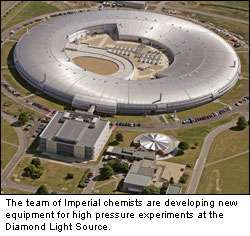Scientists develop new high pressure experiment station

A group of Imperial chemists headed by Professor John Seddon are developing a new piece of equipment to carry out experiments at extremely high-pressures at Diamond Light Source, the UK's new national synchrotron facility. The team hope their device will enable scientists to recreate the high pressure conditions of deep-sea environments and study the changes in structure that occur between cells in the human body.
The synchrotron is a multimillion pound facility which consists of a doughnut-shaped building around which electrons are accelerated to almost the speed of light. Extremely powerful x-rays shoot off at a tangent to the electron ring, and scientists in different experimental stations, or 'beamlines', in the Diamond complex use these x-ray beams to perform very high resolution analysis of biological and other molecules.
Now a team of Imperial scientists are working on creating a new piece of kit which will enable biological samples to be analysed using the Diamond x-ray beams, whilst under pressures of up to 7,000 times higher than atmospheric pressure – and over three times greater than the pressures on the deepest parts of the ocean floor. The equipment will also allow scientists to vary the pressure which the sample is subject to extremely quickly – with changes taking less than five milliseconds.
When complete, the equipment will be located at the 'beamline I22' experimental station at the Diamond Synchrotron, where it will be an open user facility, which scientists from all over the UK will be able to apply to use for work in a wide variety of areas.
Dr Nick Brooks from Imperial's Department of Chemistry, who is working on the project, explained how his team hope to use the new equipment to analyse biological fat molecules: "The diamond synchrotron is a really exciting experimental resource for scientists who want to analyse molecular structure at very high speed and resolution. Our new bit of kit will also enable this to be done under high pressure conditions.
"In terms of the work we hope to do, biological lipids that are found in cells form many different structures under different pressure conditions. Studying these structures and the changes between them will enable us to gain a greater understanding of fundamental biological processes, including cell-to-cell communication and many other aspects of membrane biophysics."
Professor Seddon, Dr Brooks and colleagues began work on this project in September 2007 thanks to a GBP 410,000 grant from the Science and Technology Facilities Council. They hope to begin testing their high pressure sample environment in early 2008, with installation of the equipment at the Diamond synchrotron anticipated for mid 2009.
Source: Imperial College London




















